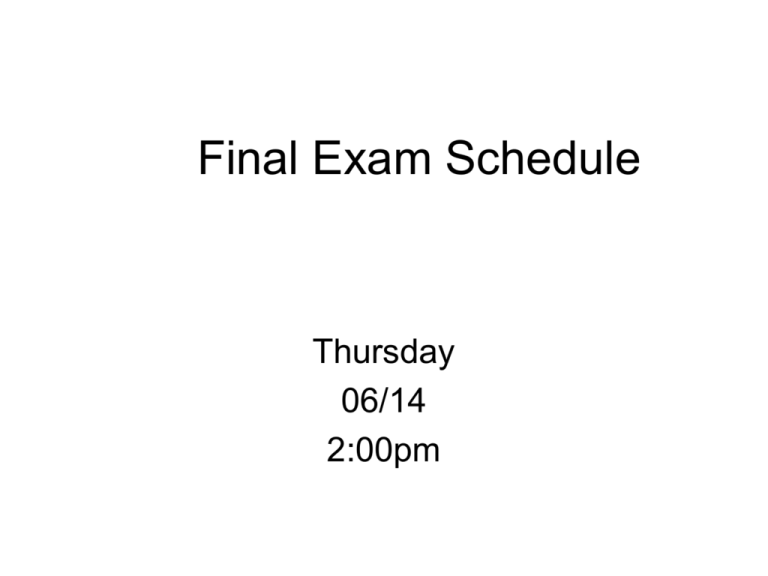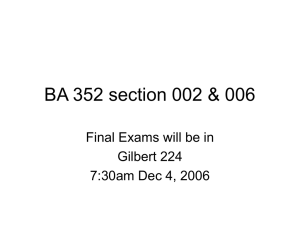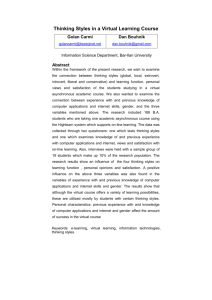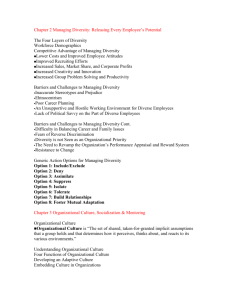BA 361 Review
advertisement

Final Exam Schedule Thursday 06/14 2:00pm Exam Structure • 40 multiple choice questions • Choose 3 out of 4 (short) essay questions • Emphasis will be on the following chapters – 4, 6, 7, 8, 9, 10, 11,12, 14, & 16 (assigned pages) – Some multiple choice questions and all essay questions will be based on the Blackgold Cases, Bob Knowlton, L.E.S., and The Politics of Performance Appraisal • bring clean copies of these cases to exam Opportunities to Review using Cases • What can we learn about the situation described in each of the cases using concepts in the chapters listed? • Blackgold (Frankie, Prakesh, Monique and Eddie) • Bob Knowlton • LES • Performance Evaluation Chapters to review • • • • • • • • • • 4 – social perception/diversity 6 & 7 – motivation 8 – feedback, rewards, reinforcement 9 – making decisions 10 – groups and teams 12 – communication 16 (assigned pages) – managing change 14 – leadership 13 – influence, power, and politics 11 – managing conflict Tips • Questions will generally be in the form of an application of a concept – When faced with this situation . . .? – This situation is called . . . ? • NOTE: The following slides are intended as a guide on topics to cover for your review. Social Perception: A Social Information Processing Model Stage 1 Selective Attention/ Comprehension Competing environmental stimuli: * People * Events * Objects Stage 2 Encoding and Simplification A B C D E F A Interpretation and categorization C F 4-4 Stereotypes A stereotype is an individual’s set of beliefs about the characteristics of a group of people. 4-5 Table 4-1 Common Perceptual Errors • Halo: A rater forms an overall impression about an object and then uses the impression to bias ratings about the object. • Leniency: A personal characteristic that leads an individual to consistently evaluate other people or objects in an extremely positive fashion. • Central Tendency: The tendency to avoid all extreme judgments and rate people and objects as average or neutral. • Recency Effects: The tendency to remember recent information. If the recent information is negative, the person or object is evaluated negatively. • Contrast Effects: The tendency to evaluate people or objects by comparing them with characteristics of recently observed people or objects. 4-7a Kelley’s Model of Attribution Basic Premise: An attribution is based on the consensus, distinctiveness, and consistency of the observed behavior. Consensus - Involves comparing an individual’s behavior with that of his or her peers. - LOW CONSENSUS indicates an individual is different from peers. Distinctiveness - Involves comparing a person’s behavior or accomplishments on one task with the behavior or accomplishments from other tasks. - Highly distinctive behavior or results represents a situation where the current behavior or result is significantly different from typical behavior or results on other tasks. 4-7b Kelley’s Model of Attribution (continued) Consistency - Involves comparing a person’s behavior or accomplishments on a given task over time. - High consistency implies that a person performs a certain task the same, time after time. Predictions - Internal or personal attributions are made when a behavior is associated with low consensus and distinctiveness, and high consistency. - External or environmental attributions are made when a behavior is related with high consensus and distinctiveness, and low consistency. Need Theories Needs are physiological or psychological deficiencies that arouse behavior. Maslow’s Need Theory •Motivation is a function of five basic needsphysiological safety, love, esteem, and selfactualization. McClelland’s Need Theory •The needs for achievement, affiliation, and power affect behavior. Approaches to Job Design 1. The Mechanistic Approach focuses on identifying the most efficient way to perform a job. Employees are trained and rewarded to perform their jobs accordingly. 2. Motivational Approaches these techniques (job enlargement, job rotation, job enrichment, and job characteristics) attempt to improve employees’ affective and attitudinal reactions and behavioral outcomes. 3. Biological and Perceptual- Motor Approaches Biological techniques focus on reducing employees’ physical strain, effort, fatigue, and health complaints. The PerceptualMotor Approach emphasizes the reliability of work outcomes by examining error rates, accidents, and workers’ feedback about facilities and equipment. Herzberg’s Motivator-Hygiene Model Motivators No Satisfaction Jobs that do not offer achievement, recognition, stimulating work, responsibility, and advancement. Satisfaction Jobs offering achievement, recognition, stimulating work, responsibility, and advancement. Herzberg’s Motivator-Hygiene Model (cont.) Hygiene Factors Dissatisfaction Jobs with poor company policies, and administration, technical supervision salary, interpersonal relationships with supervisors, and working conditions. No Dissatisfaction Jobs with good company policies, and administration, technical supervision, salary, interpersonal relationships with supervisors, and working conditions. Causes of Job Satisfaction • Need Fulfillment: Satisfaction is based on the extent to which a job satisfies a person’s needs. • Discrepancies: Satisfaction is determined by the extent to which an individual receives what he or she expects from a job. • Value Attainment: Satisfaction results from the extent to which a job allows fulfillment of one’s work values. • Equity: Satisfaction is a function of how “fairly” an individual is treated at work. • Trait/Genetic Components: Satisfaction is partly a function of personal traits and genetic factors. 7-2b Figure 7-1b Negative and Positive Inequity (cont) B. Negative Inequity Self $2 = $2 per hour 1 hour Other $3 1 hour = $3 per hour 7-2c Figure 7-1c Negative and Positive Inequity (cont) C. Positive Inequity Other Self $3 = $3 per hour 1 hour $2 = $1 per hour 1 hours 8-5 Nontraditional Feedback Upward Feedback: Subordinates evaluate their manager’s style and performance. 360-Degree Feedback: Specific (typically anonymous) feedback generated by one’s manager, peers, subordinates, and other key people. For group discussion: Are you in favor of this trend toward nontraditional feedback? Explain. What are its limits? Simon’s Normative Model of Decision Making •Based on the notion of bounded rationality, i.e. decision makers face a variety of constraints •Decision making is characterized by * limited information processing * use of judgmental heuristics (rules, shortcuts) * satisficing Decision Making Styles High Analytical Conceptual Directive Behavioral Low Tasks and Technical Concerns People and Social Concerns Value Orientation 10-3a Figure 10-1 Tuckman’s Five-Stage Theory of Group Development Performing Adjourning Norming Storming Forming Dependence/ interdependence Independence Return to Independence More Formal Group Problem Solving Techniques • Brainstorming - disciplined process – Silent idea (optional) – Ideas/opinions solicited and written on a board, disallowing criticisms, allowing piggy-backing on ideas, clarification • Delphi technique is another, more formal form of brainstorming. Involves several rounds of questionnaire, feedback, etc. Useful in cases where participants are not in the same place. 16-3 Lewin’s Change Model •Unfreezing - Creates the motivation to change - Encourages the replacement of old behaviors and attitudes with those desired by management - Entails devising ways to reduce barriers to change - Creates psychological safety • Changing - Provides new information, new behavioral models, or new ways of looking at things - Helps employees learn new concepts or points of view - Role models, mentors, experts, benchmarking results, and training are useful mechanisms to facilitate change •Refreezing - Helps employees integrate the changed behavior or attitude into their normal way of doing things - Positive reinforcement is used to reinforce the desired change - Coaching and modeling help reinforce the stability of change 16-7a Resistance To Change Resistance to Change: an emotional/behavioral response to real or imagined work change. The leading reasons why people resist change are: • • • • • An individual’s predisposition toward change Surprise and fear of the unknown Climate of mistrust Fear of failure Loss of status and/or job security 13-2a Nine Generic Influence Tactics Rational persuasion. Trying to convince someone with reason, logic, or facts. Inspirational appeals. Trying to build enthusiasm by appealing to others’ emotions, ideals, or values. Consultation. Getting others to participate in planning, making decisions, and changes. Ingratiation. Getting someone in a good mood prior to making a request; being friendly, helpful, and using praise or flattery. Personal appeals. Referring to friendship and loyalty when making a request. 13-2b Nine Generic Influence Tactics Exchange. Making express or implied promises and trading favors. Coalition tactics. Getting others to support your effort to persuade someone. Pressure. Demanding compliance or using intimidation or threats. Legitimating tactics. Basing a request on one’s authority or right, organizational rules or polices, or express or implied support from superiors. 11-3a Antecedents of Conflict • • • • • • • Incompatible personalities or value systems. Overlapping or unclear job boundaries. Competition for limited resources. Interdepartment/intergroup competition. Inadequate communication. Interdependent tasks. Organizational complexity. 11-3b Antecedents of Conflict (continued) • Unreasonable or unclear policies, standards, or rules. • Unreasonable deadlines or extreme time pressure. • Collective decision making. • Decision making by consensus. • Unmet expectations. • Unresolved or suppressed conflict. Tips for Managers Whose Employees Are Having a Personality Conflict 1. Follow company policies for diversity, antidiscrimination, and sexual harassment. 2. Investigate and document conflict. 3. If appropriate, take corrective action (e.g., feedback or behavior modification). 4. If necessary, attempt informal dispute resolution. 5. Refer difficult conflicts to human resource specialists or hired counselors for formal resolution attempts and other interventions. 11-6 Figure 11-1 Minimizing Inter-group Conflict: An Updated Contact Model Level of perceived Inter-group conflict tends to increase when: • Conflict within the group is high • There are negative interactions between groups (or between members of those groups) • Influential third-party gossip about other group is negative Recommended actions: • Work to eliminate specific negative interactions between groups (and members). • Conduct team building to reduce intragroup conflict and prepare employees for cross-functional teamwork. • Encourage personal friendships and good working relationships across groups and departments. • Foster positive attitudes toward members of other groups (empathy, compassion, sympathy). • Avoid or neutralize negative gossip across groups or departments. 11-8 Figure 11-2 Concern for Others Five Conflict-Handling Styles High Integrating Obliging Compromising Low Dominating Avoiding High Low Concern for Self Source: MA Rahim, “A Strategy for Managing Conflict in Complex Organizations, Human Relations, January 1985, p 84. Used with author’s permission. These type of topics may lend themselves more to “definition type” questions 8-3 Ch 8: Feedback Feedback: “Objective information about individual or collective performance.” Functions of Feedback: - Instructional - Motivational Sources of Feedback -Task -Self - Others 14-2b Trait Theory (continued) • Gender and leadership - men and women were seen as displaying more task and social leadership, respectively - women used a more democratic or participative style than men, and men used a more autocratic and directive style than women - men and women were equally assertive - women executives, when rated by their peers, managers and direct reports, scored higher than their male counterparts on a variety of effectiveness criteria 14-3 Behavioral Styles Theory • Ohio State Studies identified two critical dimensions of leader behavior. 1. Consideration: creating mutual respect and trust with followers 2. Initiating Structure: organizing and defining what group members should be doing • University of Michigan Studies identified two leadership styles that were similar to the Ohio State studies - one style was employee centered and the other was job centered • Blake and Mouton’s Managerial Grid represents four leadership styles found by crossing concern for production and concern for people • Research shows that there is not one best style of leadership. The effectiveness of a particular leadership style depends on the situation at hand. 11-4 Desired Outcomes of Conflict Agreement: Strive for equitable and fair agreements that last. Stronger relationships: Build bridges of goodwill and trust for the future. Learning: Greater self-awareness and creative problem solving.




